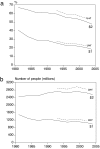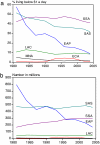Absolute poverty measures for the developing world, 1981-2004
- PMID: 17942698
- PMCID: PMC2040450
- DOI: 10.1073/pnas.0702930104
Absolute poverty measures for the developing world, 1981-2004
Abstract
We report new estimates of measures of absolute poverty for the developing world for the period 1981-2004. A clear trend decline in the percentage of people who are absolutely poor is evident, although with uneven progress across regions. We find more mixed success in reducing the total number of poor. Indeed, the developing world outside China has seen little or no sustained progress in reducing the number of poor, with rising poverty counts in some regions, notably sub-Saharan Africa. There are encouraging signs of progress in all regions after 2000, although it is too early to say whether this is a new trend. We also summarize results from estimating a new series incorporating an allowance for the higher cost of living facing poor people in urban areas. This reveals a marked urbanization of poverty in the developing world, which is stronger in some regions than others, although it remains that three-quarters of the poor live in rural areas.
Conflict of interest statement
The authors declare no conflict of interest.
Figures


Similar articles
-
Urbanization and health in developing countries.World Health Stat Q. 1991;44(2):62-9. World Health Stat Q. 1991. PMID: 1926894 Review.
-
Birth and death in cities in the developing world.Popul Briefs. 1995 Jun;1(2):6. Popul Briefs. 1995. PMID: 12319545
-
Urban health: people living below the poverty line.Health Millions. 1998 Nov-Dec;24(6):2-4. Health Millions. 1998. PMID: 12321869
-
[Imitative urbanisation and the outward growth of African cities].Tiers Monde (1960). 1985 Oct-Dec;26(104):849-59. Tiers Monde (1960). 1985. PMID: 12267621 French.
-
Strategies to maintain health in the Third World.Trop Med Parasitol. 1991 Dec;42(4):428-32. Trop Med Parasitol. 1991. PMID: 1796244 Review.
Cited by
-
The Millennium Development Goals: a cross-sectoral analysis and principles for goal setting after 2015 Lancet and London International Development Centre Commission.Lancet. 2010 Sep 18;376(9745):991-1023. doi: 10.1016/S0140-6736(10)61196-8. Lancet. 2010. PMID: 20833426 Free PMC article. No abstract available.
-
The utilisation of domestic goats in rural and peri-urban areas of KwaZulu-Natal, South Africa.Trop Anim Health Prod. 2023 May 17;55(3):204. doi: 10.1007/s11250-023-03587-3. Trop Anim Health Prod. 2023. PMID: 37195342 Free PMC article.
-
Tackling the African "poverty trap": the Ijebu-Ode experiment.Proc Natl Acad Sci U S A. 2007 Oct 23;104(43):16781-6. doi: 10.1073/pnas.0704765104. Epub 2007 Oct 17. Proc Natl Acad Sci U S A. 2007. PMID: 17942687 Free PMC article.
-
Mercury Exposure in Artisanal and Small-Scale Gold Mining Communities in Sukabumi, Indonesia.J Health Pollut. 2020 Dec 2;10(28):201209. doi: 10.5696/2156-9614-10.28.201209. eCollection 2020 Dec. J Health Pollut. 2020. PMID: 33324506 Free PMC article.
-
Financial risk protection of Thailand's universal health coverage: results from series of national household surveys between 1996 and 2015.Int J Equity Health. 2020 Sep 21;19(1):163. doi: 10.1186/s12939-020-01273-6. Int J Equity Health. 2020. PMID: 32958064 Free PMC article.
References
-
- Chen S, Ravallion M. World Bank Res Observer. 2004;19:141–170.
-
- Ravallion M. In: Welfare, Development, Philosophy and Social Science: Essays for Amartya Sen's 75th Birthday. Basu K, Kanbur R, editors. Oxford: Oxford Univ Press; 2007. in press.
-
- Chen S, Ravallion M. Rev Income Wealth. 2001;47:283–300.
-
- Ravallion M, Chen S, Sangraula P. New Evidence on the Urbanization of Global Poverty. Washington, DC: World Bank; 2007. Policy Research Working Paper 4199.
-
- Bhalla S. Imagine There's No Country: Poverty, Inequality and Growth in the Era of Globalization. Washington, DC: Institute for International Economics; 2002.
MeSH terms
LinkOut - more resources
Full Text Sources

